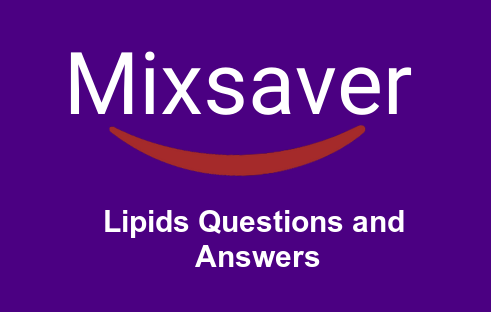MCQs on Lipids | Multiple Choice Questions on Fats and Oils
1. All of the following have 18 carbon atoms, except
(a) linoleic acid
(b) palmitic acid
(c) linolenic acid
(d) stearic acid
Ans. b
2. All are essential fatty acids except
(a) linoleic acid
(b) stearic acid
(c) linolenic acid
(d) arachidonic acid
Ans. b
3. Choose the correct statement from the following
(a) most of the naturally fatty acids have trans double bonds
(b) arachidonic acid is relatively a non-essential fatty acid
(c) the melting point of a fatty acid increases with the increasing degree of unsaturation in the hydrophobic chain
(d) the membrane lipids are rich in saturated fatty acids
Ans. b
4. Cholesterol is a precursor of all except
(a) vitamin-D
(b) steroids
(c) bilirubin
(d) bile salts
Ans. c
5. Glycerol is used for the synthesis of all of the following except
(a) triacylglycerol
(b) glycolipids
(c) glucose
(d) phospholipids
Ans. c
6. Which of the following is a fatty acid with 16 carbon atoms and one double bond?
(a) Elaidic acid
(b) Oleic acid
(c) Palmitoleic acid
(d) Erucic acid
Ans. c
7. Prostacyclins are synthesised in
(a) basophils
(b) gastric mucosa
(c) platelets
(d) endothelial cells
Ans. d
8. Iodine number is a
(a) measure of number of-OH groups in a fat
(b) measure of volatile fatty acids in fat
(c) degree of rancidity of a fat
(d) degree of unsaturation of fat
Ans. d
9. What are the components of a ceramide?
(a) Glycerol + Fatty acids + Phosphoric acid
(b) Giycerol + Fatty acids + Phosphoric acid + Nitrogenous base
(c) Sphingosine + Fatty acids + Phosphoric acid
(d) Sphingosine + Fatty acid
Ans. d
10. Which out of the following is not a derived lipid?
(a) PGE 2
(b) Diacylglycerol
(c) Ketone body
(d) Galactosyl ceramide
Ans. d
The degree of unsaturation of lipids can be measured as
11. Sphingosine is not present in
(a) plasmalogen
(b) sphingomyelin
(c) cerebrosides
(d) gangliosides
Ans. a
12. Triacylglycerols are
(a) energy rich compounds
(b) can be stored in unlimited amounts
(c) non-polar in nature
(d) All of the above
Ans. d
13. The normal level of serum in total cholesterol is
(a) 150-220 mg/dl
(b) 100-200 mg/dl
(c) 1.5-2.5 mg/dl
(d) 20-40 mg/dl
Ans. a
14. Which one is a fatty acid with 20 carbon atoms and five double bonds?
(a) Clupanodonic acid
(b) Nervonic acid
(c) Timnodonic acid
(d) Arachidonic acid
Ans. c
15. Endogenously synthesised triacylglycerol are transported from liver to extra hepatic tissue by
(a) LDL
(b) VLDL
(c) HDL
(d) chylomicrons
Ans. b
16. Which of the following does not belong to glycosphingolipids?
(a) Cerebrosides
(b) Globosides
(c) Sphingomyelin
(d) Gangliosides
Ans. c
17. Gangliosides contain
(a) sialic acid
(b) ceramide structure
(c) glucose of galactose
(d) All of these
Ans. d
18. An essential building block of phosphatidic acid and phosphatidylcholine is
(a) glucose
(b) cholesterol
(c) lysine
(d) glycerol
Ans. d
19. Which statement about thromboxane A2 is false?
(a) Causes vasodilation
(b) Causes platelet aggregation
(c) Derived from membrane phospholipid
(d) Its production is increased by non-steroidal anti-inflammatory drugs
Ans. a
20. Concentration of sphingomyelins are increased in
(a) Fabry’s disease
(b) Febrile disease
(c) Nienmann-pick disease
(d) Gaucher’s disease
Ans. c
MCQ on Lipid Metabolism
21. Cholesterol is essential for normal membrane functions because
(a) it cannot be made by higher organisms
(b) catalyses lipid flip flap in the bilayer
(c) spand the thickness of the bilayer
(d) keeps membranes in form fluid
Ans. d
22. The combination of an amino alcohol, fatty acid and sialic acid forms
(a) phospholipids
(b) sulpholipids
(c) glycolipids
(d) aminolipids
Ans. c
23. Which of the following lipids have a net negative charge?
(a) Phosphatidylserine
(b) Phosphatidylcholine
(c) Cholesterol
(d) Phosphatidylethanolamine
Ans. a
24. Alkaline hydrolysis of a triglyceride is
(a) dehydration
(b) hydrogenation
(c) esterification
(d) saponification
Ans. d
25. Paraffin wax is
(a) ester
(b) cholesterol
(c) acid
(d) monohydric alcohol
Ans. a
26. A saturated fatty acid is
(a) arachidonic acid
(b) stearic acid
(c) oleic acid stearic acid
(d) linolenic acid
Ans. b
27. Lipids are insoluble in water as they are
(a) hydrophilic
(b) hydrophobic
(c) zwitter ions
(d) neutral
Ans. b
28. Afatty acid that is not synthesised in the human body is
(a) cholesterol
(b) linoieic acid
(c) glycerol
(d) None of these
Ans. b
29. Unsaturated fats are made saturated by
(a) polymerisation
(b) hydrogenation
(c) dehydrogenation
(d) hybridisation
Ans. b
30. The most essential fatty acid is
(a) arachidonic acid
(b) linolenic acid
(c) linoleic acid
(d) oleic acid
Ans. c
Multiple Choice Questions on Lipids pdf
31. Number of fatty acid residues present in one molecule of fat is
(a) 4
(b) 3
(c) 2
(d) 1
Ans. b
32. Phospholipids are
(a) amphibolic
(b) amphipathic
(c) hydrophobic
(d) hydrophilic
Ans. b
33. Which of the following essential fatty acid has three double bond?
(a) Linolenic acid
(b) Arachidonic acid
(c) Linoleic acid
(d) Clupanodonic acid
Ans. a
34. Phospholipids are important cell membrane constituents because they
(a) contain glycerol
(b) can form bilayers in water
(c) combine covalently with protein
(d) contain both polar and non-polar ends
Ans. d
35. Rich source of polyunsaturated fatty acids in the diet is
(a) milk
(b) butter
(c) vegetable oil
(d) eggs
Ans. c





